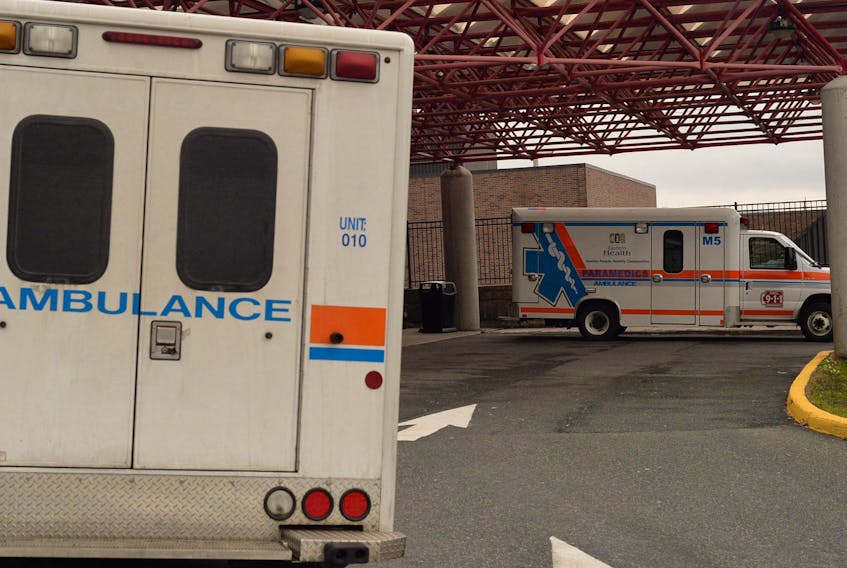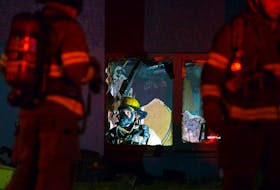ST. JOHN'S, N.L. — With her father, Bernard Hawco, severely burned and onboard in May, Florrie Drake wondered if the ambulance would make it to St. John’s from Chapel’s Cove.
Hawco, 85, survived the ordeal of first- and second-degree burns after his clothes caught fire while he was burning brush on his land, but died in late June of pneumonia he contracted while in the Health Sciences Centre, where he had remained since the ambulance trip.
Drake was home on holidays with her husband in May to spend time with her father when the fire happened. A few months later, Drake is back in Calgary, and has hard and not-so-hard days dealing with the terrible loss.
Drake, a health and safety specialist, has lingering questions about the ambulance system in Newfoundland and Labrador.
She was shocked that the province has one of the most liberal policies when it comes to ambulance lifespan — 500,000 kilometres or 10 years.
“It took forever for the ambulance to get there. The police were there. The fire trucks were there before the ambulance,” Drake said in a telephone interview.
Though she praised the ambulance staff, she was concerned about the condition of the ambulance.
Sitting in the ambulance's front seat, she said, she could feel the air coming in through the door of the vehicle.
“Is this normal?” she said she asked the Fewer’s Ambulance Services Ltd. driver, explaining she hadn’t experienced that riding in ambulances in Calgary.
According to Drake, the radio in the ambulance didn’t work, so there was no call to the Health Sciences Centre about their impending arrival.
She is skeptical if the ambulance was capable of going any faster.
“There were no sirens. I don’t think we hit over 100 at all,” said Drake, who texted a cousin for the emergency room number and told him they were on the way.
“I don’t think they thought he was an urgent case. They thought his vital signs were somewhat stable.”
Later, at the hospital, Drake learned the extent of his injuries and need for surgery, and she was told to contact family, she said.
“That’s when the light went on and, ‘Oh my God.’ I knew the burns were serious. You’re in shock,” Drake said, adding that her father received premium care in hospital.
Robert Fewer, who owns Fewer’s Ambulance Services Ltd., and some other ambulances in the province, said via email he was aware of the call, but not aware of the details The Telegram asked him about.
He said he has contacted the management team and will have them do an internal investigation into the call on that particular transfer.

“I heard about the incident from the news and asked our staff if we had responded to the call. They confirmed it. I had no reason to ask for any more information on the call since that, but I will find out about the statements that have been made,” Fewer said.
The Telegram had reported on the fire and a neighbour who rushed to Hawco’s aid, as well as his subsequent death from pneumonia.
Fewer said he needed more time to answer questions surrounding mileage and how the ambulances are purchased.
He offered the opinion, however, that other provinces are moving toward extending the life of their ambulances.
The Telegram has been comparing this province’s policies to the nine other provinces and also obtained data from Service NL on odometer readings at last inspection for nearly 250 ambulances in this province dated throughout 2018.
All of the ambulances, including Fewer’s, passed the Service NL inspections.
Thirty-two ambulances exceeded 400,000 kilometres on the odometer.
Sixty-three had between 300,000 and 400,000 kilometres on the odometer.
About 150 in total exceeded 200,000 kilometres.
Service NL also said that, due to mechanical reasons, some ambulances are removed from service before reaching the cap.
Eastern Health has among the newest ambulances in the province, as does Central Health.
Ambulances purchased by the regional health authorities are bought new and are retired at 250,000 kilometres, said Health Minister John Haggie.
The province’s ambulance system is a mish-mash of public, private and not for profit. The approximately 60 private licences are held by about four companies, Haggie noted.
Many privately operated ambulances carry the highest mileages.
Rick Gill of Teamsters Local 855, which represents 250 paramedics in the private ambulance sector in Newfoundland and Labrador, said the union has sort of given up on raising issues about the age and high mileage of private ambulances, as the issue has fallen on deaf ears.
“It’s definitely a concern,” Gill said of used ambulances coming into the province when they are no longer in service elsewhere due to tougher rules for mileage and age.
Trudy Fiander, owner of Marystown Ambulance, said she buys used ambulances from Ontario, as ambulances new are too expensive — more than $100,000 each.
“We haven’t had a big deal of trouble with them,” Fiander said of the used vehicles, which her mechanic maintains.
“They are mostly highway miles — there is a lot of back and forth to St. John’s,” she said.
In 2011, Newfoundland and Labrador’s auditor general noted in a report that thresholds for age and/or kilometres established by the Health Department are significantly higher than thresholds established for other provinces.
The Health Department is revising the road ambulance system, looking at a variety of sweeping reforms.
It’s a blank sheet, said Haggie.
Private operators are being consulted. The current contracts expire in the next couple of years and the province is working with private operators to design a system that will allow the small and medium operators to continue to thrive, he said.
He noted Justice and Public Safety’s review of radio communications systems will have an impact on the Health Department as well, as the first responders’ systems are coming to the end of their useful life and there is new technology the province needs to bring in.
As for mileage, Haggie also noted many of the rural operators’ miles are highway driving, while in St. John’s — where the runs are short — anecdotal information suggests it can be a struggle to get three years out of an ambulance.
He said as long as the ambulances all pass Service NL annual inspections, he’s comfortable with their age and odometers.
“We don’t have any evidence at the moment that it is causing any problems,” he said.
However, the mileage and age maximums will be looked at as part of the reform.
Another change that’s coming is to have the Health Department or a designate inspect the medical equipment onboard, rather than Service NL mechanics, as is done now.
Twitter: @BarbSweetTweets
How ambulance odometer and/or age limits in Newfoundland and Labrador compare to other provinces
ONTARIO
Ontario downloaded ambulance responsibility onto the municipalities in 2000.
A spokeswoman for the Regional Municipality of York, which stretches north from Toronto to Lake Simcoe, told The Telegram ambulances there are replaced every five years or 250,000 kms.
That’s half the lifespan of a Newfoundland and Labrador ambulance.
When they reach their cap, the York ambulances are turned back to the dealer for credit on new ones or donated to non-profits. In April, one of the two donations went to the Caribbean.
BRITISH COLUMBIA
BC Emergency Health Services has a general target of 350,000 kilometres for the average lifecycle of its ambulances. Ambulances are decommissioned after reaching this mileage, usually about seven to eight years of service.
Some decommissioned ambulances are repurposed as support vehicles or training vehicles. High-volume ambulances are often relocated midlife to stations with lower call volumes in order to increase their lifespan.
ALBERTA
In Alberta, there is not a legislated maximum for the mileage an ambulance can have and still be permitted to operate, but there are legislated requirements for ambulance safety inspections to be completed every 180 days, and any subsequent repairs identified during the inspection must be completed by licensed technicians before it can be placed into service again.
NEW BRUNSWICK
There is no upper limit on mileage for New Brunswick ambulances, but they are taken out of service after four years.
NOVA SCOTIA
Nova Scotia leases its vehicles and replaces them every four years.
Emergency Health Services conducts both random and scheduled inspections on vehicles to confirm fleet safety and contract compliance, and aims to return leased vehicles within the mileage limits set out in the lease agreement — maximum 400,000 kms.
PRINCE EDWARD ISLAND
Each ambulance in P.E.I. is decommissioned and replaced with a new vehicle approximately every five years.
Island EMS’s fleet renewal plan considers not only the number of kilometres but the model of ambulance and vehicle fuel type. etc. Most of Island EMS’s fleet are now Mercedes Benz Type-2 Sprinter ambulances (diesel) that are currently manufactured by Demers Ambulances based in Quebec. These ambulances include a manufacturer recommended lifespan of up to 750,000 kms. Island EMS replaces these vehicles at 500,000 kms.
MANITOBA
The average lifespan of an ambulance in Manitoba is 300,000 kilometres.
QUEBEC
There is no mileage limit written in the ambulance companies’ contracts with the Ministry of Health and Social Services in Quebec.
However, vehicles are replaced at about 300,000-325,000 kms.
SASKATCHEWAN
In Saskatchewan, there are no set standards or policies for maximum ambulance age or odometer readings.









